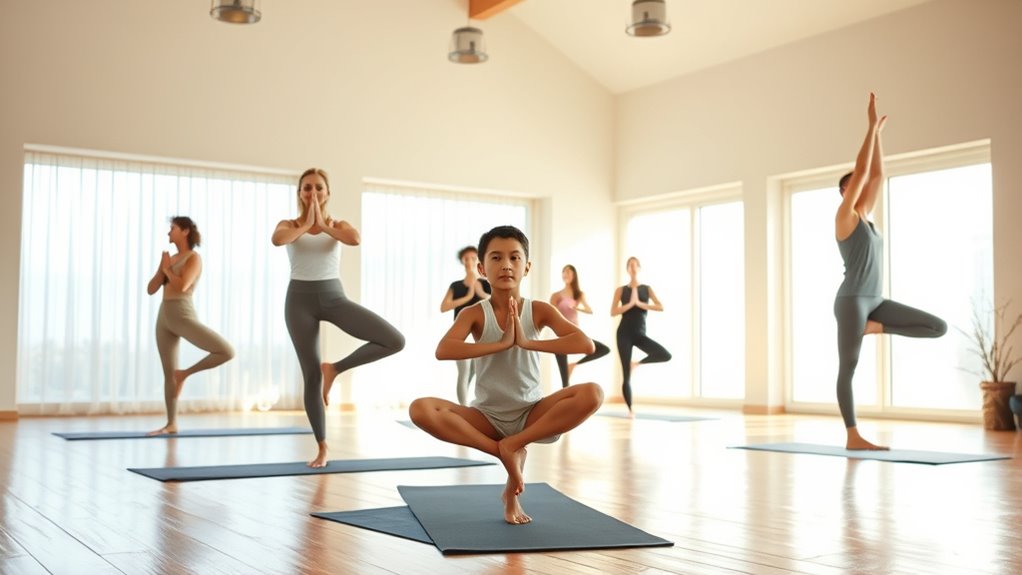Starting your yoga journey with these seven basic poses is a great way to improve flexibility, build strength, and find calm. Focus on foundational poses like mountain, downward dog, and warrior to develop proper alignment and breath awareness. Synchronizing your breath with movement enhances focus and stability. As you progress, you’ll discover how simple practices can transform your body and mind. Keep exploring, and you’ll uncover even more ways yoga can enrich your life.
Key Takeaways
- Focus on foundational poses like Mountain and Downward Dog to build strength, flexibility, and body awareness.
- Synchronize breath with movement to enhance focus, stability, and relaxation during each pose.
- Practice proper alignment and mindful breathing to prevent injury and deepen your yoga experience.
- Incorporate breath awareness and meditation to develop concentration and reduce stress.
- Consistent, gentle practice of basic poses creates lasting physical and mental benefits for beginners.

Are you curious about starting yoga but unsure where to begin? The good news is, you don’t need to be an expert to enjoy its many benefits. The first step is understanding that yoga isn’t just about physical poses; it’s also about cultivating mindfulness through breathing techniques and meditation practices. These foundational elements help you build a solid practice that can reduce stress, improve flexibility, and boost your overall well-being.
Begin by focusing on your breath. Breath awareness is the cornerstone of yoga and can be practiced anywhere. Start with simple breathing techniques like diaphragmatic breathing, where you breathe deeply into your belly rather than shallowly into your chest. As you inhale, feel your abdomen expand, then slowly exhale, feeling your belly contract. This kind of mindful breathing calms your nervous system and prepares you for more advanced practice. Incorporate meditation practices into your routine by sitting quietly for a few minutes each day, focusing on your breath or a calming word or phrase. Meditation helps you develop concentration, reduces anxiety, and enhances your ability to stay present during your yoga practice.
Once you’re comfortable with breathing and meditation, you can move on to basic poses that are accessible for beginners. Start with mountain pose (Tadasana), which teaches proper alignment and helps you connect with your body. Stand tall with your feet hip-width apart, arms relaxed by your sides, and focus on grounding through your feet while maintaining a steady breath. From there, try downward dog (Adho Mukha Svanasana), which stretches your hamstrings, calves, and shoulders. Keep your hands shoulder-width apart, press your heels toward the floor, and breathe deeply. These poses are fundamental because they improve strength and flexibility while encouraging mindfulness of your body and breath.
Incorporating breathing techniques during your poses can make a significant difference. For example, synchronize your breath with movement—inhale as you raise your arms in a stretch or exhale as you fold forward. This connection between breath and movement enhances focus and stability. Remember, yoga isn’t about perfect postures; it’s about listening to your body and practicing with patience. As you become more comfortable, you’ll notice how these simple poses, combined with mindful breathing and meditation practices, start to influence other areas of your life.
Additionally, understanding the foundational elements of yoga, such as proper alignment and breathing techniques, can help prevent injury and deepen your practice. Starting with these basic poses and mindfulness techniques creates a strong foundation for your yoga journey. Over time, as your confidence grows, you can explore more challenging postures and deepen your meditation practices. The key is consistency—regular practice will help you reap the physical and mental benefits that can truly change your life. So, take that first step, breathe deeply, and enjoy the journey of discovering what yoga can do for you.
Frequently Asked Questions
How Often Should Beginners Practice Yoga for Optimal Results?
You might wonder how often you should practice yoga for the best results. Typically, a consistent practice is key. Aim for about three to four sessions per week to establish a solid routine. This practice frequency helps improve flexibility and strength without causing burnout. Creating an ideal schedule that fits your lifestyle ensures you stay committed, making yoga a beneficial part of your daily routine and enhancing your overall well-being.
Can Yoga Help With Specific Health Issues or Injuries?
Yoga can definitely help with specific health issues or injuries through targeted yoga therapy, which focuses on healing and rehabilitation. It promotes injury prevention by improving flexibility, strength, and posture. By practicing carefully tailored poses, you may diminish pain and support recovery. Always consult a healthcare professional first, and work with a qualified instructor to ensure safe, effective practice that addresses your unique health needs.
What Should I Wear to My First Yoga Class?
For your first yoga class, wear comfortable yoga clothing that allows free movement. Opt for breathable, stretchy fabrics like leggings or shorts and a fitted top or tank. Avoid loose or restrictive attire to stay comfortable during poses. As a beginner, your goal is to focus on practice, so choose simple beginner attire that makes you feel confident and comfortable. This way, you’ll move freely and enjoy your first session fully.
Is Yoga Suitable for All Age Groups and Fitness Levels?
Think of yoga as a gentle river that flows through everyone’s life. It’s highly age inclusive and adapts to your fitness level, welcoming all. Whether you’re young or old, fit or just starting, yoga offers a safe space for growth and healing. Your journey is unique, and yoga’s flexibility guarantees you can participate comfortably, nurturing your body and mind at any stage of life.
How Do I Choose the Right Yoga Style for Me?
When choosing the right yoga style, consider your personal preferences and fitness goals. Explore different yoga styles like Hatha, Vinyasa, or Restorative to see which resonates with you. Think about whether you want a more relaxing practice or a physically challenging one. Trying out beginner classes or online videos can help you find the style that feels best, making your yoga journey enjoyable and sustainable.
Conclusion
So, there you have it—just seven simple poses to transform your life. Who knew that a few stretches could make you more centered, flexible, and zen? It’s almost funny how something so easy could be so powerful, right? So go ahead, give these a try. Who needs a gym or therapy when a little downward dog and a bit of breathing can do the trick? Your new, calmer life is just a pose away.









